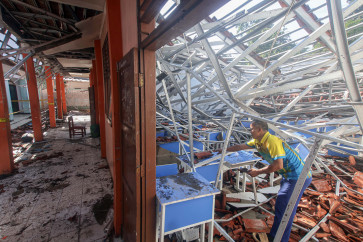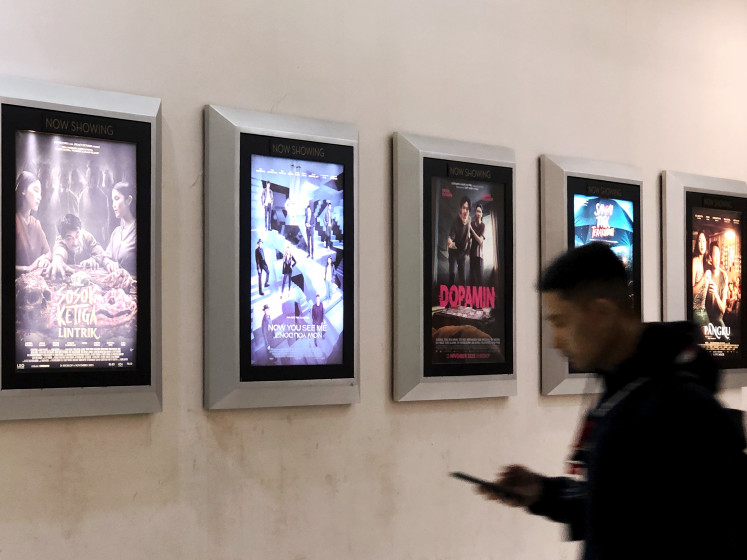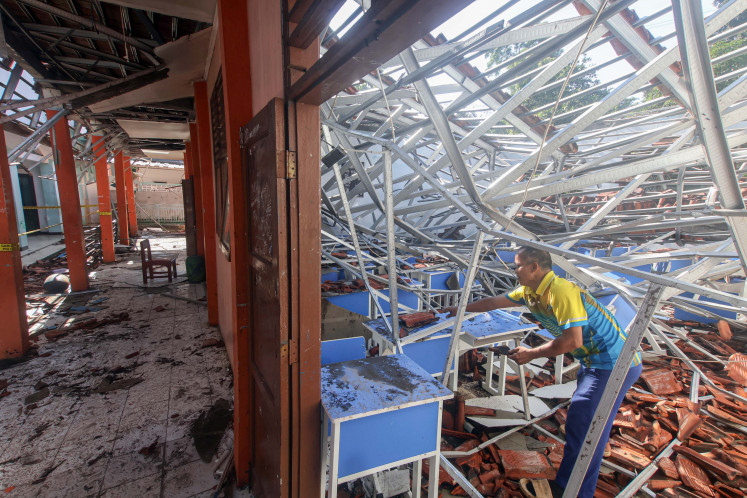Popular Reads
Top Results
Can't find what you're looking for?
View all search resultsPopular Reads
Top Results
Can't find what you're looking for?
View all search resultsH2 of 2020: Hoping for one engine to revive economic growth
On the flip side, positive support came from the shift of the rice harvest season from Q1 of 2020 to Q2 of 2020, this was one the reasons why 1Q20 performance was unexpectedly lower than most of the forecasts.
Change text size
Gift Premium Articles
to Anyone
A
s expected, Indonesia’s economic growth contracted 5.3 percent in the second quarter, following significant deceleration in the previous quarter. It was lower than our forecast of a 6.1 percent contraction but higher than the market consensus. Most of the contraction came from sectors that have been hit heavily by the COVID-19 pandemic as well as the large-scale social restrictions (PSBB), such as transportation, retail and wholesale trade.
On the flip side, positive support came from the shift of the rice harvest season from Q1 of 2020 to Q2 of 2020, this was one the reasons why 1Q20 performance was unexpectedly lower than most of the forecasts. The harvest shift drove a 2.19 percent year-on-year (yoy) increase in the agriculture sector, which contributes around 15 percent of Indonesia’s GDP. It is worth noting that manufacturing and agriculture are the biggest contributors to Indonesia’s economy, with a combined share of around 30 percent. Furthermore, both account for around 44 percent of the total workforce in Indonesia. Thus, seasonally the harvesting period will have a positive impact on the quarterly performance as well as the purchasing power of the farmer during that period.
From the expenditure side, household spending plummeted 5.51 percent yoy (vs 2.83 percent yoy in Q1 of 2020 and 5.18 percent yoy in Q2 of 2019) as a consequence of the implementation of PSBB limiting personal spending, particularly for transportation and recreation during Idul Fitri.
Moreover, government spending decelerated by 6.9 percent yoy as declining tax revenues amid the pandemic hampered the government’s economic stimulus realization, and gross fixed capital formation (GFCF) or investment plunged 8.61 percent yoy (vs 1.7 percent yoy in Q1 of 2020 and 4.55 percent yoy in Q2 of 2019) due to lower demands which forced many businesses to halt their investment activities, especially in vehicles and equipment.
Declining investment activity caused imports to contract 16.96 percent yoy (vs -2.19 percent yoy in Q1 2020 and -6.84 percent yoy in Q2 2019) as a huge chunk of imports (around 90 percent) were raw material and capital goods. This also caused service imports such as shipping to fall. Exports decelerated by 11.66 percent yoy (vs 0.23 percent yoy in 1Q20 and -1.73 percent yoy in 2Q19) amid the global lockdowns, lowering the global demand. The decline, however, was less than imports, thus a trade surplus was still recorded.
Now, the million-dollar question will be: What is the outlook for the second half? We believe that, at this juncture, the recovery to the pre-COVID-19 performance level will take a long time. The only game changer will come if a vaccine is found and proven. Prior to that, the recovery will heavily depend on how fast government spending can be disbursed in the third quarter.
Indonesia still has room to have full-year positive growth despite all of the global challenges that affect two engines of growth, investment and trade.
There are three drivers to support growth if the government successfully accelerates government spending:
(i) Indonesians still have a relatively high willingness to spend or consume compared to other countries. Currently, the marginal propensity to consume (MPC) in Indonesia reached around 0.52, or around 52 percent of total income was spent for consumption. This translates into a higher fiscal multiplier impact of around two times, derived from the equation of 1/(1-MPC). Thus, additional government spending of around Rp 100 trillion (US$6.85 billion) will lead to additional economic growth of around Rp 200 trillion. We expect that the government will push the cash transfer this quarter to support the economy at least in the last quarter this year;
(ii) Several pieces of anecdotal evidence revealed that the economy had improved and bounced back from the rock-bottom level in March and April. Our Big Data analysis, using Google Maps data, depicted that the mall visit rate rebounded to between 40 and 50 percent of the pre-COVID-19 level post-PSBB relaxation between July 1 and 5. Most of the consumers went to the supermarket to buy groceries while others went for personal care. In the same period, the restaurant visit rate increased to around 30 and 40 percent of pre-COVID-19 levels.
The rate depicted that when consumer confidence was back to the pre-COVID-19 level, people started to dine out and reallocate their spending to secondary goods. It is worth noting that consumer confidence has become the major concern for middle to upper consumers during the COVID-19 pandemic. Thus, the confidence will soar when the government has successfully contained the virus;
(iii) Commodity prices were relatively stable in the third quarter or passed the rock-bottom level last quarter. Based on our calculation, coal prices were stabilized in July and August while CPO and rubber prices increased 6.3 percent and 2.6 percent respectively in July. The same pattern occurs in August, when CPO prices improved on a month-on-month basis, reaching $683 per ton (vs an average of $533 per ton in Q2 of 2020). We believe that the prices will be normalized but will not touch the lowest level in the last quarter. This is a good basis to expect that sales of other goods that relate closely to the commodity sector, such as automotive and heavy equipment, will improve despite the fact that it will not be back to pre-COVID-19 levels anytime soon.
Those three factors are supposedly the main factors that Indonesia will improve in the second half. In this case, the accelerated spending is important to assure that the recovery curve will not be flattened or head south.
It is worth noting that some sectors could still be resilient with a low break-even point (BEP), such as retail — both fast-moving consumer goods (FMCG) and non-FMCG — with a BEP between around 30 and 40 percent of revenue, while others require a higher BEP level at above 45 percent such as restaurants and hotels. Thus, keeping the people’s confidence to spend will be as important as keeping the purchasing power for the middle to lower income level to assure the recovery path is heading north.
At this juncture, we believe the government will be able to tackle all economic challenges as well as health sector issues to keep Indonesia’s economy on the right track to recovery.
-----
Chief economist of Bank Mandiri










